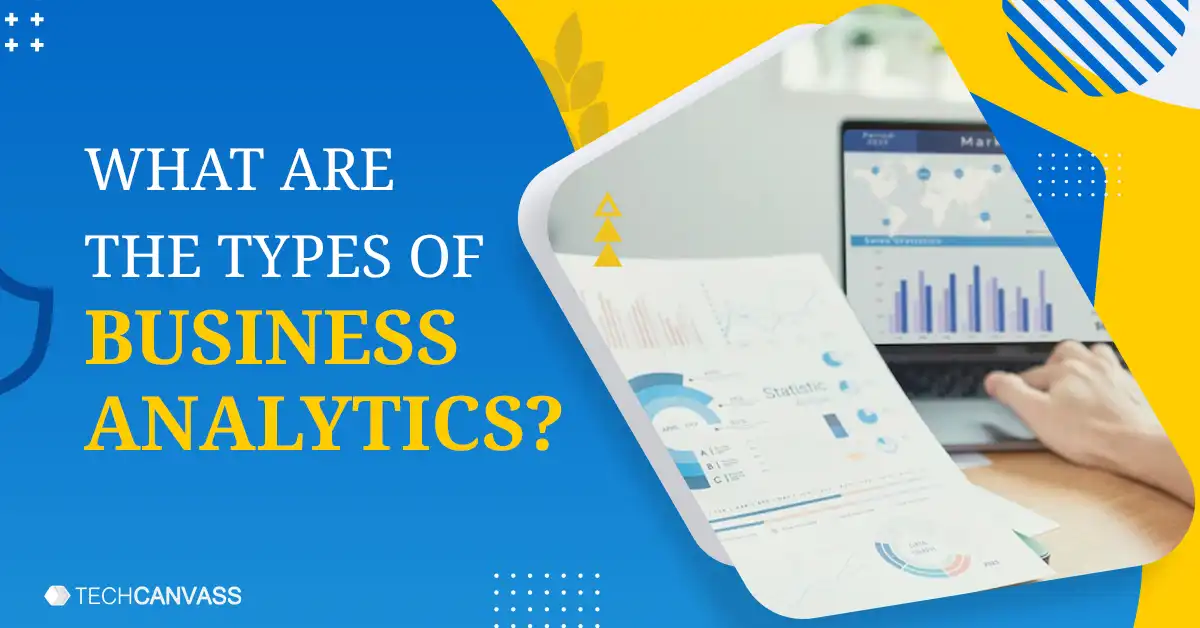Last Updated on November 9, 2024 by Techcanvass Academy
Data is a crucial asset for any industry, including finance, healthcare, social media, energy, retail, real estate, and manufacturing, hence understanding how to evaluate it is crucial. But the data itself would be meaningless, unstructured, and unfiltered. Knowing the methods and types of business analytics can help us understand what this data represents and how it can be used, which will help us gain useful insights into it.
In this guide, we will take a look at the different types of business analytics. But, before we do that, you can check out our Business Analytics Certification Training that we offer to enhance your knowledge and gain a better understanding of what data analytics is all about and simultaneously gain a credential by IIBA.
Let’s head into the article!
What is Business Analytics?
Business analytics (BA) is a collection of methodologies and tools for applying data analysis, statistical modeling, and other quantitative techniques to address business issues. It involves a rigorous, iterative analysis of the data within an organization with a focus on statistical analysis to inform decision-making. Understanding the different types of business analytics—descriptive, diagnostic, predictive, and prescriptive—can help organizations make more informed, data-driven decisions and optimize their operations.
Business analytics success depends on high-quality data, knowledgeable analysts who comprehend the industry and technologies, and a dedication to leveraging data to uncover insights that guide business choices. Understanding the types of business analytics—descriptive, diagnostic, predictive, and prescriptive—is essential for harnessing the full potential of data to drive strategic decisions and achieve business objectives.
Types of Business Analytics
Business Analytics is probably one of the most important IT functions for any business, pertaining to the insight and business value it can generate for any enterprise. Its ability to look beyond the clutter of data and generate sensible interpretations for strategic decisions makes it so valuable. By exploring the types of business analytics—descriptive, diagnostic, predictive, and prescriptive—businesses can gain deeper insights and make more informed, data-driven decisions that drive success.
But did you know that the word “business analytics” actually refers to a variety of different things, including the following:
Descriptive Analytics:
This is the most basic form of analytics and very closely resembles erstwhile Business Intelligence. In one of our articles on Descriptive analytics, we have discussed it in more details.
Customers by far most frequently utilize descriptive analytics, which offers reporting and analysis focused on historical occurrences. It aids businesses in understanding questions like:
- How much did the business sell?
- How productive were we as a whole?
- How many clients left in the most recent quarter?
The easiest place for a business to start is with descriptive analytics because data is frequently easily accessible to create reports and applications. Descriptive analytics is utilized to understand the full effectiveness at an aggregate level. It is one of the key types of business analytics, helping businesses gain insights into historical data and assess overall performance to inform strategic decision-making.
Diagnostic Analytics:
Analytics experts can use diagnostic analytics to ascertain why something occurred.
And in order to understand why something occurred in the past, diagnostic analytics is applied. It is described using methods like drill-down, data discovery, data mining, and correlations. To identify the underlying causes of occurrences, diagnostic analytics examines data more closely. It is helpful in figuring out what events and variables led to the result. The study mainly makes use of possibilities, probabilities, and the dispersion of outcomes.
Predictive Analytics:
Based on the analysis of historical data, predictive analytics can assist an organization in forecasting the expected outcome. In one of our earlier posts on Predictive analytics, we have discussed it in detail.
To predict future events on a certain level, predictive analytics uses the obtained data and findings from descriptive and diagnostic analytics. Here, the information from the prior processes can be transformed into useful insights for making decisions. As one of the essential types of business analytics, predictive analytics is used to foresee the future, predict market trends, track shifting consumer behavior, and analyze competitors. This helps businesses optimize and develop strategies to maximize corporate results and stay ahead in the market.
In order to make the forecasts, data from the past is analyzed, patterns and haphazard relationships are found, and the predictions are then extrapolated to the future.
Prescriptive Analytics:
Prescriptive Analytics, which employs a number of statistical techniques, largely draws inspiration from computer science and mathematics.
Prescriptive analytics emphasizes practical insights rather than data monitoring, although being closely related to both descriptive and predictive analytics. This is accomplished by compiling information from a variety of descriptive and predictive resources and using it to inform decision-making. Then, algorithms construct and recreate potential choice patterns that might affect an organisation differently.
Prescriptive analytics is particularly useful since it can assess the effects of a choice based on several future possibilities and then suggest the best course of action to pursue in order to meet a company’s objectives. As one of the advanced types of business analytics, prescriptive analytics goes beyond predicting future outcomes by recommending actionable strategies to optimize business performance and decision-making.
Myths about Business Analytics
Here are some myths about business analytics that you can look into and not be overwhelmed by the business analytics domain.
You need advanced math skills
Business analytics is built on using everyday human intelligence, which may be used to address any problem in any industry. As a result, creating analytical models does not require sophisticated mathematical procedures. For professionals in all fields, math knowledge acquired up to the 10+2 level is sufficient and can serve as a foundation. Furthermore, learning math beyond a basic level is not a need to understand the fundamentals of business analytics.
Learning Business Analytics Requires Programming
Since the majority of the tools and approaches are simple to use, a professional can study business analytics without having any prior programming knowledge.
Data visualization software Tableau even offers drag-and-drop features that make it incredibly simple for anyone to get started. Because of this, business analytics has become so widely used in all fields, and experts from a wide range of sectors find it to be a terrific career choice and a logical step forward in their careers. However, one will need to become well-versed in statistics.
A Business Analytics Profile Is about cleansing and crunching Numbers
The process of number crunching, also known as cleaning, slicing, and dicing data, involves transforming an unstructured data collection into a structured one. These tasks do not, however, define a business analytics professional’s profile.
Being an effective business analyst only requires learning the necessary tools and techniques
While mastering Python, R, or SAS can help you land an interview, without domain expertise and business sense, it would be difficult for anyone to perform well in their current position. Therefore, it is a myth when it is said that simply learning business analysis tools are techniques is enough for becoming a good business analyst.
Read More –
Tools in Business Analytics
Business analytics tools aid analysts in carrying out their duties and producing reports that might be simple enough for easier understanding. Here are some business analytics tools that business analysts use for their day-to-day responsibilities.
SAS
The SAS Institute for Data Management in North Carolina created the statistical software suite (SAS) for data management, advanced analytics, and predictive analytics. Thanks to its strong nature and simple to understand approaches, it is currently widely used by business analysts.
Tableau
Tableau is a great business intelligence tool with a focus on data discovery and visualization of data. A business analyst can quickly analyse, visualise, and share data using the software. Tableau supports a variety of data sources, that includes MS Excel, Oracle, MS SQL, Google Analytics, and SalesForce. Users will have access to user-friendly dashboards that have been thoughtfully built.
Read In Detail – Tableau Certification – A Comprehensive Exam Guide
Power BI
Power BI, a powerful business analytics tool from Microsoft, empowers organizations to transform raw data into insightful visualizations. With its user-friendly interface and robust capabilities, Power BI allows businesses to monitor key performance indicators, identify trends, and make data-driven decisions. By leveraging features like drag-and-drop report creation, real-time data connectivity, and advanced analytics, users can gain deep insights into their business operations. Whether it’s analyzing sales figures, tracking customer behavior, or forecasting future trends, Power BI provides the tools to unlock the full potential of your data.
R
R is an open-source programme that is totally free to use. However, it can have a very steep learning curve because you need to master the fundamentals of coding, even if many forums and online communities publish frequently on its usage.
Python
Python stands out for its overall qualities and has a relatively regular syntax. Because it focuses on simplicity and readability, it has a short and smooth learning curve. Python is an extremely versatile language that may be used for web scripting. It is primarily utilised when it is necessary to integrate the data analysis with a web application or when statistics must be employed in the creation of a database.
Conclusion
This article talks about the types of business analytics and discusses each type in a detailed manner. Each type of business analytics may be implemented by the business analyst depending upon the type of project and the analysis required for a different type of data. If you think this article was informational, let us know in the comment section.



